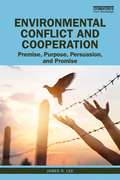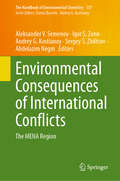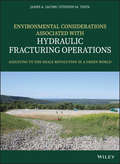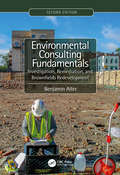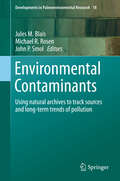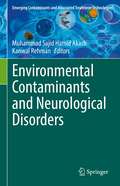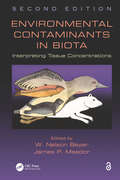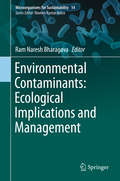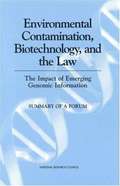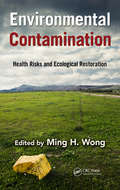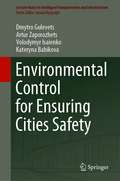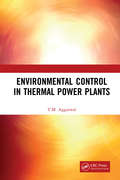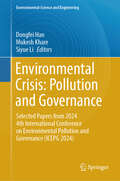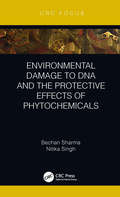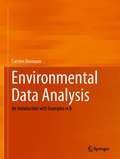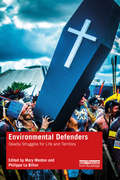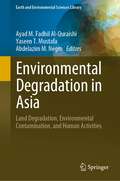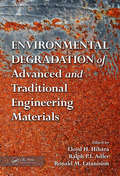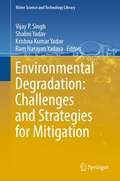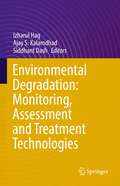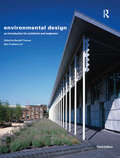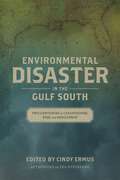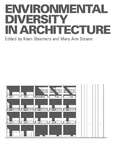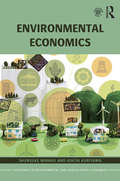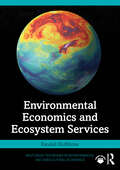- Table View
- List View
Environmental Conflict and Cooperation: Premise, Purpose, Persuasion, and Promise
by James R. LeeEnvironmental Conflict and Cooperation explores the evolution of environmental conflict as a field of research and the study of cooperation as an alternative to war. Over four key parts, James R. Lee navigates the contours of this growing field and paints a vivid framework for better understanding issues around environmental conflict and security: • The premise of the field and its historic manifestations • The definition and purpose of research • The persuasions or types of environmental conflict and cooperation • The promise of research in leading to better decision-making and to broaching new challenges. Over the course of these parts, the author outlines the deep historic record of this discipline, arguing that it will play a key role in understanding important future trends. Utilizing a wide variety of case studies that range from ancient examples, including conflict over the Cedars of Lebanon and the role of tin in the Peloponnesian Wars, to future-oriented scenarios, including expanded island-building in the South China Sea and the global politics of geo-engineering, Lee highlights key concepts, metrics, and policy contexts that will test current understandings. He also examines a variety of research methods and provides examples of the ways in which such research can be used to inform policy improvements. This book will draw specific interest from students and scholars of environmental conflict and cooperation, as well as researchers of environmental politics and security studies.
Environmental Consequences of International Conflicts: The MENA Region (The Handbook of Environmental Chemistry #137)
by Andrey G. Kostianoy Igor S. Zonn Sergey S. Zhiltsov Aleksander V. Semenov Abdelazim NegmThis is the first of two volumes that, taken together, provide an integrated picture of the environmental consequences arising from international conflicts. The volumes build upon the successful book Environmental Consequences of War and Aftermath published in The Handbook of Environmental Chemistry in 2009. The books focus on environmental consequences only and discuss land degradation, erosion, water scarcity and pollution, water resources management, air pollution, desertification, deforestation, food scarcity and radioactive contamination, among others. This volume addresses conflicts in the MENA region (Middle East and North Africa), covering historical and more recent events such as water conflicts, military conflicts, migration and overpopulation, and infrastructure projects. Readers will also find several chapters in this book on the theory of international conflicts and their impact on the environment in general. Given its breadth, this book appeals to environmental scientists, policy makers, and researchers interested in the environmental impacts of international conflicts.
Environmental Considerations Associated with Hydraulic Fracturing Operations: Adjusting to the Shale Revolution in a Green World
by James A. Jacobs Stephen M. TestaA guide to environmental and communication issues related to fracking and the best approach to protect communities Environmental Considerations Associated with Hydraulic Fracturing Operations offers a much-needed resource that explores the complex challenges of fracking by providing an understanding of the environmental and communication issues that are inherent with hydraulic fracturing. The book balances the current scientific knowledge with the uncertainty and risks associated with hydraulic fracking. In addition, the authors offer targeted approaches for helping to keep communities safe. The authors include an overview of the historical development of hydraulic fracturing and the technology currently employed. The book also explores the risk, prevention, and mitigation factors that are associated with fracturing. The authors also include legal cases, regulatory issues, and data on the cost of recovery. The volume presents audit checklists for gathering critical information and documentation to support the reliability of the current environmental conditions related to fracking operations and the impact fracking can have on a community. This vital resource: Contains the technical information and mitigation recommendations for safety and environmental issues related to hydraulic fracturing Offers an historical overview of conventional and unconventional oil and gas drilling Explains the geologic and technical issues associated with fracking of tight sand and shale formulations Presents numerous case studies from the United States EPA and other agencies Discusses issues of co-produced waste water and induced seismicity from the injection of wastewater Written for environmental scientists, geologists, engineers, regulators, city planners, attorneys, foresters, wildlife biologists, and others, Environmental Considerations Associated with Hydraulic Fracturing Operations offers a comprehensive resource to the complex environmental and communication issues related to fracking.
Environmental Consulting Fundamentals: Investigation, Remediation, and Brownfields Redevelopment, Second Edition
by Benjamin AlterThis book is a primer for those interested in a career in this dynamic, multidisciplinary field as well as a handy reference for practicing consultants. Combining theory and practice advice into a concise, readable format, the book is an accessible introduction to the types of projects you will encounter as an environmental consultant and lays the groundwork for what you’ll need to know in this challenging and rewarding profession. Also available with this book, under the Additional Resources tab, are PowerPoint lectures that correspond with each chapter. New in the Second Edition Covers the latest environmental issues, including emerging contaminants, and the latest technological advances in environmental investigation and remediation New chapters dedicated to vapor intrusion investigation and mitigation and to Brownfields redevelopment and project financing. An expanded chapter describing the staffing, budgeting, and execution of environmental projects. Descriptions of the remediation processes under RCRA and Superfund Descriptions on how each chapter’s subject matter applies to the job of the environmental consultant. Dozens of new figures, photographs, and tables designed to enhance the reader’s understanding of the subject matter. Problems and questions to be used for homework assignments or classroom discussions.
Environmental Contaminants
by John P. Smol Jules M. Blais Michael R. RosenThe human footprint on the global environment now touches every corner of the world. This book explores the myriad ways that environmental archives can be used to study the distribution and long-term trajectories of chemical contaminants. The volume first focuses on reviews that examine the integrity of the historic record, including factors related to hydrology, post-depositional diffusion, and mixing processes. This is followed by a series of chapters dealing with the diverse archives and methodologies available for long-term studies of environmental pollution, such as the use of sediments, ice cores, sclerochronology, and museum specimens.
Environmental Contaminants and Neurological Disorders (Emerging Contaminants and Associated Treatment Technologies)
by Muhammad Sajid Hamid Akash Kanwal RehmanThis volume discusses how environmental pollutants are involved in the pathogenesis of neurological disorders, and covers specific mechanisms and risk factors, as well as the necessary strategies to reduce the adverse impacts of environmental pollutants on the human nervous system. With a collection of contributions from experts in environmental pollution, neurology and pharmaceutical chemistry, the book provides both an introduction to the pathogenesis of neurodegeneration, including the types and different classes of neurological disorders, and studies demonstrating the clear link between environmental contaminants (e.g. pesticides, smoking, mycotoxins, persistent organic pollutants (POP's), polychlorinated biphenyls, phthalates, nanomaterials) and the development of neurological disorders in vulnerable populations. The book fills in a gap in research on the topic by also covering state-of-the-art treatment strategies and mitigation measures for each type of pollutant. The book will be of interest to environmental scientists, pharmacologists, toxicologists, biochemists, biotechnologists, and food and drug regulatory organizations.
Environmental Contaminants in Biota: Interpreting Tissue Concentrations, Second Edition
by W. Nelson BeyDiscussing the interpretation of tissue concentrations of contaminants in wildlife, this updated edition of a bestseller draws on current scientific research and includes new chapters and greater emphasis on aquatic organisms. Each chapter provides a summary and review of a specific chemical along with direction on research methods and the interpretation of conflicting or insufficient data. Chapters include a comprehensive history of contaminant interpretation in wildlife and fish, the use of tissue residues in ecological risk assessment, and detailed coverage of all bioaccumulative contaminants and their physiologic affects.
Environmental Contaminants: Ecological Implications and Management (Microorganisms for Sustainability #14)
by Ram Naresh BharagavaAs we know, rapid industrialization is a serious concern in the context of a healthy environment. Various physico-chemical and biological approaches for the removal of toxic pollutants are available, but unfortunately these are not very effective. Biological approaches using microorganisms (bacterial/fungi/algae), green plants or their enzymes to degrade/detoxify environmental contaminants such as endocrine disrupting chemicals, toxic metals, pesticides, dyes, petroleum hydrocarbons and phenolic compounds are eco-friendly and low cost. This book provides a much-needed, comprehensive overview of the various types of contaminants, their toxicological effects on the environment, humans, animals and plants as well as various eco-friendly approaches for their management (degradation/detoxification). As such it is a valuable resource for a wide range of students, scientists and researchers in microbiology, biotechnology, environmental sciences.
Environmental Contamination, Biotechnology, and the Law: The Impact of Emerging Genomic Information
by Robert PoolA report on Environmental Contamination, Biotechnology, and the Law
Environmental Contamination: Health Risks and Ecological Restoration
by Ming H. WongBringing together the research of 62 distinguished scientists in one volume, Environmental Contamination: Health Risks and Ecological Restoration offers a comprehensive view of the remediation of contaminated land. A one-stop resource, it covers historical and emerging contaminants, the issues of bioavailability of chemicals and their associated hu
Environmental Control for Ensuring Cities Safety (Lecture Notes in Intelligent Transportation and Infrastructure)
by Volodymyr Isaienko Artur Zaporozhets Dmytro Gulevets Kateryna BabikovaThis proceedings book is devoted to the development of environmental analysis of the surface layer of atmospheric air and green areas of urbanized areas. The analysis of scientific and methodological developments for assessing the level of environmental safety of urbanized areas, taking into account the influence of chemical and physical factors, is carried out. The choice of criteria for assessing the ecological state of the surface layer of atmospheric air is theoretically substantiated. The hazard index of the surface layer of atmospheric air, taking into account the influence of chemical and physical factors, and a method of its visual representation are proposed. An assessment of the environmental risk of the influence of the surface layer of the atmosphere was carried out. A quantitative assessment of the energy balance of the green zone is carried out for Kyiv city (Ukraine). Schemes for informing the population about the ecological state of air in real time are developed. The book is for researchers, engineers, as well as lecturers and postgraduates of higher education institutions dealing with issues of atmospheric pollution, ecological safety and urbanization.
Environmental Control in Thermal Power Plants
by T.M. AggarwalFrom wood and coal to predominantly oil and natural gas. Thermal Power Plants use fuels for power generation. Water is used for process, cooling, as well as for service/drinking requirement. Chemicals are used for conditioning of water, corrosion-control and sometimes for conditioning of fuel as well. Lubricants are used for machinery. These inputs generate waste products. Human related wastes (sewage etc.) are also generated along with the processed waste. These pollutants/wastes need to be treated before their disposal from the plants. The treated effluents are required to meet the limits set by Central / State Pollution Control Boards. The regulations, issued by these agencies, specify the maximum allowable limits applicable to the pollutants discharge from the Power Plants. This book is a serious effort that deals in detail with all the above issues and we are sure that scientists, academicians, researchers and professionals who are constantly facing these issues and are striving to move towards a zero emission regime, will find this monograph a very useful reference tool on the topic.Note: T&F does not sell or distribute the Hardback in India, Pakistan, Nepal, Bhutan, Bangladesh and Sri Lanka.
Environmental Crisis: Selected Papers from 2024 4th International Conference on Environmental Pollution and Governance (ICEPG 2024) (Environmental Science and Engineering)
by Mukesh Khare Dongfei Han Siyue LiThis book presents cutting-edge research findings on environmental pollution and remediation, covering key areas such as pollution analysis and monitoring, as well as pollution control and restoration. At the 2024 UN Environment Assembly, environmental pollution and remediation were once again defined as one of the three major crises facing the planet. The global environmental pollution issue remains severe; despite the efforts of many countries and regions, the situation is still far from optimistic. Issues such as heavy metals and radioactive contamination in seawater are gradually becoming significant topics in environmental pollution. Accurate composition analysis and effective remediation strategies are essential in addressing pollution, and enhancing the accuracy of pollutant source analysis and the effectiveness of harmless pollution management are key subjects of discussion in this book. Furthermore, the book aims to facilitate the exchange of scientific information among scholars from leading universities, research centers, and high-tech enterprises around the world. This book will be highly beneficial to scholars, engineers, and researchers in the fields of environmental engineering and environmental remediation.
Environmental Damage to DNA and the Protective Effects of Phytochemicals
by Bechan Sharma Nitika SinghEnvironmental Damage to DNA and the Protective Effects of Phytochemicals provides information on the toxicity of natural as well as synthetic chemicals in the living systems. These can lead to DNA damage and the emergence of serious consequences or manifestations causing varied health hazards. In addition, the ten chapters of the book reflect on the possible applications of plants or plant extracts to impart protection for living cells from the xenobiotics-mediated DNA damage. The book offers comprehensive coverage of the many essential topics in the subject including: Environmental factors and DNA damage Molecular mechanisms associated with DNA damage by various environmental (Physical, Chemical and Biological) factors Synergistic effects of environmental factors Phytochemicals acting both as DNA protectants and genotoxicants Experimental models for the study of the genotoxic potential of environmental factors and protection by phytochemicals This book connects readers who possess a life sciences background to the current understanding, concept and mechanisms involved in environmental-factors-mediated DNA damage. Scientific terms are introduced, defined, described and placed appropriately in the text. The protective effect of some plant extracts/phytochemicals has also been included. Environmental Damage to DNA and the Protective Effects of Phytochemicals is intended to cater the need of BSc, MSc and research students who are striving to discover the mechanism(s) associated with protection of DNA by plant-based chemicals. This is the first edition of our book and the valuable suggestions and comments from the readers are solicited.
Environmental Data Analysis: An Introduction with Examples in R
by Carsten DormannEnvironmental Data Analysis is an introductory statistics textbook for environmental science. It covers descriptive, inferential and predictive statistics, centred on the Generalized Linear Model. The key idea behind this book is to approach statistical analyses from the perspective of maximum likelihood, essentially treating most analyses as (multiple) regression problems. The reader will be introduced to statistical distributions early on, and will learn to deploy models suitable for the data at hand, which in environmental science are often not normally distributed. To make the initially steep learning curve more manageable, each statistical chapter is followed by a walk-through in a corresponding R-based how-to chapter, which reviews the theory and applies it to environmental data. In this way, a coherent and expandable foundation in parametric statistics is laid, which can be expanded in advanced courses.The content has been “field-tested” in several years of courses on statistics for Environmental Science, Geography and Forestry taught at the University of Freiburg.
Environmental Defenders: Deadly Struggles for Life and Territory (Routledge Explorations in Environmental Studies)
by Mary Menton; Philippe Le BillonThis book is about environmental defenders and the violence they face while seeking to protect their land and the environment. Between 2002 and 2019, at least two thousand people were killed in 57 countries for defending their lands and the environment. Recent policy initiatives and media coverage have provided much needed attention to the protection and support of defenders, but there has so far been little scholarly work. This edited volume explains who these defenders are, what threats they face, and what can be done to help support and protect them. Delving deep into the complex relations between and within communities, corporations, and government authorities, the book highlights the diversity of defenders, the collective character of their struggles, the many drivers and forms of violence they are facing, as well as the importance of emotions and gendered dimensions in protests and repression. Drawing on global case studies, it examines the violence taking place around different types of development projects, including fossil fuels, agro-industrial, renewable energy, and infrastructure. The volume also examines the violence surrounding conservation projects, including through militarized wildlife protection and surveillance technologies. The book concludes with a reflection on the perspectives of defenders about the best ways to support and protect them. It contrasts these with the lagging efforts of an international community often promoting economic growth over the lives of defenders. This volume is essential reading for all interested in understanding the challenges faced by environmental defenders and how to help and support them. It will also appeal to students, scholars and practitioners involved in environmental protection, environmental activism, human rights, social movements and development studies.
Environmental Degradation in Asia: Land Degradation, Environmental Contamination, and Human Activities (Earth and Environmental Sciences Library)
by Abdelazim M. Negm Yaseen T. Mustafa Ayad M. Fadhil Al-QuraishiThis unique book focuses on environmental degradation in Asian countries including land degradation and soil erosion. The land degradation covers assessing environmental degradation using geospatial technology, land use land cover mapping, environmental and anthropogenic degradation, assessment of land degradation vulnerability, evaluation of the impact of earthquake and the environmental control of the sand dunes. It also addresses the soil degradation and environmental pollution and presents several case studies such as tectonic activity and erosion, assessment of aircraft sound, soil degradation assessment for the arid territories, soil pollution, waste engine oil contamination, soil degradation, soil erosion modelling, land use and land cover change and its effect on soil erosion changes. Additionally, the book discusses the impact of climate change, and human activities including urban environmental quality, air pollution and the impact of armed conflict on the environment. Moreover, topics such as vegetation degradation including forest changes, hydrological and agricultural drought are presented. The book includes authors and scientists from Egypt, Iraq, Iran, India, Mongolia, United Arab Emirates, Uzbekistan, Republic of Kazakhstan, USA, Turkey, South Africa, Italy, China, Malaysia, Poland and Russia. Graduate students, researchers, engineers, policy planners, policymakers and stockholders could benefit from the information and the knowledge in this book.
Environmental Degradation of Advanced and Traditional Engineering Materials
by Lloyd H. Hihara Ronald M. Latanision Ralph P.I. AdlerOne of the main, ongoing challenges for any engineering enterprise is that systems are built of materials subject to environmental degradation. Whether working with an airframe, integrated circuit, bridge, prosthetic device, or implantable drug-delivery system, understanding the chemical stability of materials remains a key element in determining t
Environmental Degradation: Challenges and Strategies for Mitigation (Water Science and Technology Library #104)
by Vijay P. Singh Shalini Yadav Ram Narayan Yadava Krishna Kumar YadavThis book discusses problems, challenges, and mitigation strategies in the wake of environmental degradation. It suggests proactive solutions to problems of environmental degradation for strategic planning as well as their effective delivery, and problems arising due to growth in population, industry, and land use change. The uniqueness of the book is its broader spectrum of coverage with related interconnections and interdependence of various aspects. Presenting a wide spectrum of viewpoints and approaches, the book covers topics, such as deforestation impacts (land use and land cover, soil erosion); impacts on climate change and human health; treatment of industrial, municipal, biological waste disposal and their impacts on soil, water, and air; recovery/remediation processes and technologies; impacts of pesticides and chemical fertilizers on soil degradation and groundwater; socio-economic environmental sustainability; and socio-economic health impacts. Particular focus is placed on strategic planning and methodological handling of environmental degradation and remediation through various processes and treatment technologies. This book will be useful to researchers, professionals, policy makers, and environmental engineers.
Environmental Degradation: Monitoring, Assessment and Treatment Technologies
by Ajay S. Kalamdhad Izharul Haq Siddhant DashThis book focuses on municipal and industrial water and wastewater treatment technologies. The chapters provide detailed information about wastewaters' occurrence, source, characteristics, toxicity, and conventional and advanced treatment process. In addition, the book presents chapters relating to different monitoring methods adopted for water quality assessment in different water bodies. This book aims to boost the knowledge of students, researchers, scientists, professors, engineers and professionals who aspire to work in the field of environmental science, environmental biotechnology, environmental microbiology, civil/environmental engineering, eco-toxicology and other relevant areas of industrial waste management for the safety of the environment. The readers of the book will obtain valuable information related to various environmental problems and their solutions.
Environmental Design: An Introduction for Architects and Engineers
by Randall ThomasWritten and edited by a team of specialists at Max Fordham LLP, one of the UK’s leading environmental and building services engineering consultancies, Environmental Design is the result of their extensive experience in designing environmentally-friendly buildings. The principles of their approach, which they have taught in numerous schools of architecture and engineering, are clearly presented here. The book starts with some basic scientific principles and environmental issues and then moves on to site planning, energy use, materials and building form. Natural ventilation systems, high-efficiency mechanical equipment and alternative energy sources are also covered. State-of-the-art buildings of exceptional quality are incorporated throughout the text and illustrate the authors’ belief that environmentally responsible architecture can be visually exciting. They conclude with a selection of detailed case studies of award-winning projects – including, new for this third edition, Beaufort Court, King's Langley and the National Trust Headquarters, Swindon. This book is essential reading for architects, engineers, planners and students of these disciplines.
Environmental Disaster in the Gulf South: Two Centuries of Catastrophe, Risk, and Resilience (The Natural World of the Gulf South #6)
by Ted Steinberg Cindy ErmusHurricanes, floods, oil spills, disease, and disappearing wetlands are some of the many environmental disasters that impact the Gulf South. The contributors to Environmental Disaster in the Gulf South explore the threat, frequency, and management of this region’s disasters from the mid-nineteenth century to the present. Scholars from the fields of history, sociology, and anthropology examine the underlying causes of vulnerability to natural hazards in the coastal states while also suggesting ways to increase resilience.Greg O’Brien considers the New Orleans flood of 1849; Andy Horowitz, the Galveston storm of 1900; and Christopher M. Church, the 1928 hurricane in Florida and the Caribbean. Urmi Engineer Willoughby delves into the turn-of-the-century yellow fever outbreaks in New Orleans and local attempts to eradicate them, while Abraham H. Gibson and Cindy Ermus discuss the human introduction of invasive species and their long-term impact on the region’s ecosystem. Roberto E. Barrios looks at political-ecological susceptibility in New Orleans’s Lower Ninth Ward, and Kevin Fox Gotham treats storm- and flood-defense infrastructures. In his afterword, Ted Steinberg ponders what the future holds when the capitalist state supports an unwinnable battle between land developers and nature.These case studies offer new ways of understanding humans’ interactions with the unique, and at times unforgiving, environment of the Gulf South. These lessons are particularly important as we cope with the effects of climate change and seek to build resilience and reduce vulnerability through enhanced awareness, adequate preparation, and efficient planning.
Environmental Diversity in Architecture
by Koen Steemers Mary Ann SteaneThis book takes the position that the dynamic of the architectural environment is a key aspect of good design, yet one which is not well anticipated or understood. Environmental variety is a design characteristic closely related to our experience of architecture - an architecture of the senses. Each chapter demonstrates how an understanding of a particular context or environmental characteristic in dynamic terms informs design. The book is an antidote to the misconceptions of 'optimum' environmental performance or fixed criteria, instead embracing the richness of environmental variety.
Environmental Economics (Routledge Textbooks in Environmental and Agricultural Economics)
by Shunsuke Managi Koichi KuriyamaThis book aids those concerned about environmental issues to firmly grasp relevant analytical methods and to comprehend the thought process behind environmental economics. It does so by drawing from specific environmental issues and at the same time providing commentary that facilitates understanding. This text contains in-depth explanations necessary for a thorough understanding of the fundamental aspects and importance of environmental economics. Environmental Economics seeks to elucidate the mechanisms that give rise to environmental problems by approaching environmental issues from an economic perspective. At the same time, it is a study aiming to indicate specific countermeasures that could resolve present environmental issues. This text has been put together in way that allows readers without specialized economics knowledge to easily understand the situation, issues and challenges of environmental economics.
Environmental Economics and Ecosystem Services (Routledge Textbooks in Environmental and Agricultural Economics)
by Randall BluffstoneEnvironmental Economics and Ecosystem Services provides a rigorous yet accessible introduction to environmental economics, using ecosystem services as the underlying framework. Assuming no prior knowledge of economics, and using a conversational writing style, the focus is on exploring society’s linkages with the environment and how economics can help solve key environmental problems.Structured in three parts, the book first introduces readers to the key theories in environmental economics and ecosystem services, and then explores the challenges of conservation. The final section examines environmental policy options, such as cap-and-trade, behavioral nudges, community-based natural resource management and carbon taxes. There is a strong international focus throughout the book, with real-life examples taken from North America, Europe, Asia, Africa and other regions. Students are supported by a range of pedagogical features, including chapter objectives, chapter summaries, discussion questions and further reading suggestions. In addition, the book offers worked examples, analytical problems and “Challenge Yourself” boxes to develop critical thinking skills. Lecture slides and answers to questions for discussion and practice problems are available for instructors.This is the ideal text for introductory courses in environmental economics, ecological economics, economics of sustainability, environmental management, environmental policy and ecosystem services.
